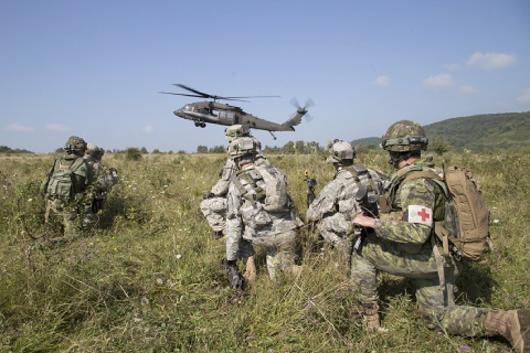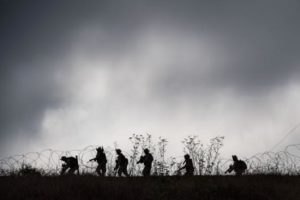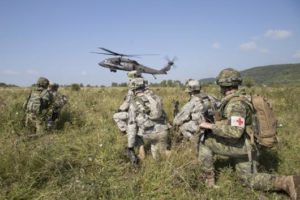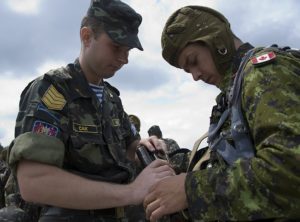It is not uncommon to hear debates on the roles Canada will need its army to perform – that is, what strategic utility it offers to Canada and to the government in the future, and what qualities, capabilities, and capacities it must possess to exercise this utility, as safely, effectively and efficiently as possible.
This is particularly true in periods between major wars, and in times of financial and defence resource challenges. Often heard, however, are expressions like ‘we won’t do this’ or ‘we don’t need that.’ These statements are largely symptomatic of under-resourcing and funding challenges for some, and the aspiration by others for the world to be something other than it is.
Responsible choices on roles for the Canadian military and the capabilities we should require it to have the need to be grounded, instead, on a shared understanding of the current and emerging security environment, Canada’s interests at stake in that environment, and the objectives Canada as a country should be advancing while protecting against vulnerabilities.
Thereafter, a debate on choices can be informed by a strategic understanding of the utility of force and forces (not just military) to advance those interests and objectives – to preserve Canada’s safety and security, and advance its contribution to the pursuit of peace and security globally, in an increasingly volatile, unstable and unpredictable world.
Human conflict plays out in many ways, and increasingly new ways and in all domains – in the air, at sea, in cyber and in space, and on the land – across all geographies. The most consistent and persistent sources of conflict, in a particular conflict that affects, attacks and traumatizes citizens/non-combatants persistently and directly, remains among people where they live.
Threats to Canadian citizens at home, and the preservation of Canada’s interests and values abroad must be met then, from time to time, by military forces contributing to defence and security effects on the land. This has been and will continue to be done through a variety of means: air, maritime, space and cyber for certain. Where and when it matters the most ultimately this means by physically deploying on the ground, amongst populations, and in the full face of manmade threats or natural disasters. This means by bringing to bear force and forces – on the ground.
The strategic utility of land forces and land operations in the safety and security of Canadians at home, and in the fight for and pursuit of peace and stability abroad, will endure. Any assessment of the future security environment calls for the government to have the option to augment civil authorities at home with land capabilities and capacities, to demonstrate presence and sovereignty through persistent presence in all corners of Canadian territory, and to respond to crises abroad through disaster response and relief, conflict prevention, security assistance, capacity building, peace enforcement and, where needed, the application of force, including lethal force, to defeat threats and adversaries in combat. This last feature of the utility of force in today’s security environment, and the security environment of the future cannot be understated. Violence and volatility are on the rise. Instability and uncertainty are on the rise.
State actors with peer to Western military power are increasingly aggressive and sophisticated in the use of force and forces in their near abroad. Violent and extremist terrorist groups continue to traumatize populations and increase their territorial influence. Where and when it is in the national interest to intervene – to prevent aggression, respond to aggression, or to defeat aggressors – a whole range of military capabilities and capacities need to be available, in particular those able to exercise force, and to coordinate, in increasingly sophisticated ways, the threat or application of force. This means, in short, combat capability.
The government will continue to need the Canadian Army to meet the no-fail safety and security missions at home, the combined Canadian and US responses for the defence of the continent, including in the Arctic, as well as the projection of land power to and application of land power in conflicts abroad. That strategic utility cannot be realized, however, unless the missions and mandates assigned, and the qualities and capabilities of that land power – generated predominantly by the Canadian Army – are real, relevant and credible. This point is key and worth discussing.
Relevance and credibility
In the fall of 1995, Canada was embroiled in its third year of the Balkan crisis. Canada had – between troops deployed in Croatia and Bosnia, maritime forces in the Adriatic, and air forces based in Italy – over 3,500 uniformed men and women fully engaged. They were operating alongside 38,000 international military partners in the so-called United Nations (UN) Protection Force (UNPROFOR) seeking to ‘keep the peace’ in the midst of the civil war there. There was no peace to keep. The Serb-led massacre at Srebrenica, violation of ‘safe areas’ in Gorazde, the assault by Croatian forces through Canadian protected areas in Croatia’s sector south, and the hostage-taking of unarmed observers – including a Canadian Military Observer chained to a bridge – typified our experience on the ground and the images shared with the world. Rules of engagement prohibited troops from using force for anything more than self-defence. They were powerless in the face of violence by the factions against civilian populations, with huge consequences for the people, as well as to the mental health and well-being of participating troops. These typified Canada’s experiences during the dark days of that UN intervention.
The international approach taken in the former Republic of Yugoslavia, and the choices taken in Canada and internationally on the utility of force in this crisis, led to a failed mission. On a good day, UN forces were an inconvenience to, or ignored by, the warring factions. On a bad day, they were pawns and hostages in their great game and witnesses to the atrocities they inflicted on each other and their peoples. UNPROFOR, thankfully, wasn’t to be the end of our pursuit of peace in that theatre of conflict. Eventually the UN, warring factions, and the world tired of this condition. In late 1995, a new framework for intervention was implemented – under a UN Chapter 7 mandate – with a clear diplomatic lead, and a capable military force under NATO was ordered into action, and a new era in the crises intervention came into play.
As the UN mission was concluding and conditions for the North Atlantic Treaty Organization’s (NATO’s) engagement were being prepared in conference rooms and embassies elsewhere, things started to change dramatically on the ground. Longstanding adversaries and combatants gradually and then dramatically reduced their combativeness, increased their level of compliance with old agreements and accords, and, in very real ways, started treating the UN military forces in Bosnia with an unseen-before degree of civility and cooperation. From blocking UN movements, confiscating equipment, and material, and threatening personal violence, the military leadership of factions almost became friendly. Why? When asked that question late in November 1995, one Bosnian Serb Colonel replied, “NATO is coming, NATO are warfighters, we aren’t going to fight NATO.”
That man’s words communicated a few simple messages. The UN mandate and military mission were not relevant to or credible in the face of the civil war. Forces were neither equipped nor credible as professionals. And, UN forces had neither the authority nor the will to use force to make a difference. UN forces were neither relevant to the crises nor credible to the factions, and were powerless and suffered because of this. On the coming NATO force, however, this Colonel’s message was the opposite.
The NATO mission was seen as relevant to and credible in the context of the conflict of the day – there were no holes in the mandate. The NATO force was deploying with the full suite of capabilities required to enforce the military provisions of the peace agreement – it was a credible force with no gaps in capability. And, NATO militaries were professionals, coming with the authority to use force, and the will to use force where required, and thus credible in their capacity and willingness to use force where necessary. The result was a peaceful and compliant transition by warring factions into their cantonment sites – no shots needing to be fired and no further loss of life. The mandate, the force’s capabilities, and its will to use force as necessary were complete – it was relevant to the challenge and credible to all factions – and the mission was able to progress while the security of deployed forces was dramatically enhanced.
Canadian troops exchanged blue berets for green helmets. Canada deployed a combat capable force with its full complement of close combat capabilities. The Canadian forces were integrated with NATO and whole-of-government partners in a more comprehensive approach to peacebuilding, including disarmament, demobilization, and reintegration. The force didn’t have to fire a shot but was absolutely equipped and prepared to do battle, aggressively, effectively and decisively, and former adversaries knew it. And Canada’s contribution went from being inconsequential to the lives of the people in the region, to a real source of security and opportunity in their post-civil-war journey.
Having real options and choices
Canada’s geography and privileged strategic position in terms of relationships, in particular with the United States, do allow the government the privilege of choice and discretion in international interventions. Still, governments have had a broad versus a narrow range of options available to them in these interventions – and citizens have been supportive when they see this. For options to be real, they need to pre-exist any particular crisis, and be within the Canadian military baseline, both Regular and Reserve forces, and the institution’s short-term potential for adaptation and expansion. New capabilities for high-risk operations cannot be manufactured and brought to bear at the speed with which crises occur and effective responses are required. If capabilities are to be considered real options for either mission of necessity or discretion, they need to be real and in existence, not imagined.
In conflicts and crises where threats, enemies, and adversaries must be engaged persistently and directly, to preserve lives and protect people where they live, deployment onto and engagement in the land domain must be an option available to Canada and Canadians. Land forces – with the Canadian Army at the centre – must be capable, confident and credible in conflict, up to and including combat. General-purpose combat capability remains the key to the confidence of Canada’s own forces to endure the danger, complexity, and uncertainty of interventions, and to their confidence and capacity to bring to bear effects and influences that achieve results in contested and conflicted zones abroad. General-purpose combat capability remains key to the credibility of Canadian forces in conflict zones, to partners alongside whom troops must operate and fight, and to the protection that credibility affords to troops.
Full spectrum, general-purpose, combat-capable
General-purpose combat capability and credibility do not come to a force through subcontracting key core components. Nor does it imply ‘owning’ the full suite of capacities within each capability area. While much can be provided by others, their offerings need to nest and integrate within one’s own force, on top of one’s own capacities. Own capabilities at the tactical level can be complemented, but not entirely replaced by another force, in particular, those functions that will always remain at the centre of general-purpose combat capacities and those enabling enduring national responsibility.
These five core capabilities remain:
- the ability to lead one’s own forces, integrate the capabilities of other forces, and work effectively alongside indigenous and whole-of-government partners (Command);
- the ability to see with one’s own sensors in the visible, electromagnetic and cyber spectrums, and to contribute and draw on partners’ abilities to see (Sense);
- the capacity to apply force up to and including lethal force – broadly or with precision – to influence an adversary’s actions, and defeat it in combat through fires and manoeuvre when needed (Act);
- the ability to protect and preserve the lives and limbs of one’s own troops, from airborne threats, improvised explosive devices (IEDs), direct and indirect fire weapons, chemical, biological and radiological threats, and health risks (Shield);
- and finally the ability to sustain all of these with supply, transportation, maintenance, logistics, and financial services (Sustain) – the whole array of back office functions that, as Napoleon put it, professionals talk about.
The Canadian Army, and a Canadian Armed Forces (CAF) generated larger joint force must provide all of these as capabilities that are core to a general-purpose force, and essential to combat capability. These core elements are key to being able to integrate capabilities provided by partners, and those offered as contributions to mission partners. Full spectrum operations – from peace to war – are a team effort, and the CAF need to bring to bear all the pieces that contribute to teams and that leverage contributions of others while commanding, shielding and sustaining Canadian forces on the ground.
At home, demonstrating presence, enforcing sovereignty, reinforcing and supporting domestic security forces, and responding to crises resulting from manmade and natural disasters, require mass.2 Typically, close combat forces of Regular and Reserve components are re-rolled to perform people-based security and general duty tasks (infantry, armour, artillery troops (Act functions) for example). The balance of the land force (again Regular and Reserve) enables the command, sense, sustain and shield functions – even providing those services to citizens and public safety organizations – from surveillance to communications, to logistics, to health services. General-purpose capabilities allow for the leadership of the full range of functions, including leading military forces on the land, providing for the integration of their actions and capabilities with joint, air, maritime and civilian partners, and assuring their protection and sustainment over time. Effective safety, security, and defence are assured, credibility with partners is preserved, and the confidence of Canadians in their government’s ability to provide for their safety is protected.
A brigade-based army
The brigade – an all arms formation of land forces – is the lowest level at which these functions exist, are led, and can be integrated effectively. This is true in force generation,3 such as the training of battle groups and other unit level forces as combined arms teams and parts of a joint force. And this is particularly true in operations, especially in complex and high-stakes operations abroad including full spectrum and combat, and in conducting complex security missions at home. The brigade is the lowest level where high threat and high-stakes land operations can be effectively integrated with coalition and civilian partners. And it is at this level where Canada can effectively integrate for employment, under the CAF, land and joint force capabilities of other militaries for land missions. It was at the brigade level that Canadians exercised operational control of the US and Dutch forces in Afghanistan. Governments should have and will want to have the opportunity not only to be a provider of forces but also to be a provider of leadership that leverages the offerings of other military forces, where that matters, in peace support as well as full spectrum operations.
A joint-capable and joint-enabled all arms brigade force structure is the lowest level at which Canada can assure its ability and capacity to generate integrated forces, and operate as a team of teams – military, civilian and multinational – in complex and high stakes missions. Brigade capabilities are the bridge for integrating air/land operations of all forms, and are the platform for planning and conducting operations ashore, projected from and supported by the maritime forces. The Canadian Army must continue to evolve brigades as the foundation of this joint and integrating capability.
The lead force generator for land operations
Canadian Joint Operations Command is the CAF’s force employer. Its mission is to lead the anticipation, preparation for and conduct of operations to defend Canada, protect North America, and contribute to peace and security abroad. Large parts of the Army’s command and control capabilities, as the other services, are assigned to CJOC for this mission. The enduring Army mission, on the other hand, is to generate combat effective, multi-purpose land forces to meet Canada’s defence objectives. The Canadian Army, like the other services, is consumed by this force development and force generation effort.
In a world where we need to be agile, adaptable and flexible in responding to shock and surprise, the Canadian Army needs to be grounded on a firm, sophisticated and modern force generation base that is adaptive, flexible and responsive in its own right. That generation base is the backbone of the Canadian Army – its system of training and development of individuals, exercising of combined arms teams, and building and delivering joint, integrated, multinational forces for land operations. The Canadian Army’s capabilities and capacities are assured (or not) by the rigour and robustness of this force generation base. This includes modern well-equipped school houses, comprehensive sets of simulations and training aids, large manoeuvre training areas that facilitate high readiness, and deploying forces to experiment, train and ‘live it out here before they live it out there,’ and the learning and change processes that go with these. The role of the Canadian Army as the lead force generator for the CAF for land operations – including its Regular and Reserve components, its civilian workforce, and the industries which support them – is delivered on the back of a unified, adaptive and resilient system of doctrine and training. This role and these capacities must also evolve and endure.
The professional’s face to Canadians
Finally, the CAF is a profession of volunteer citizens, supported by families and enabled by communities. The profession’s ability to endure is founded on people, and on a healthy number and quality of citizens who volunteer to join. As the largest element of the CAF with the most diverse presence in communities across Canada – in particular by virtue of a healthy and proud Reserve component – the Canadian Army should continue to play a key role to connect, in real and meaningful ways, with fellow citizens. The endurance of its human capital and the assurance of public engagement and support will continue to rely on this personal and ‘in my neighbourhood’ presence.
Conclusion
Canada’s strategic relevance in a world in distress, and its real ability to advance and protect its interests at home and abroad, will continue to rely on the strategic utility of force in the range of crises to come, the reality of relevant options for government, and on the operational and tactical credibility of Canadian forces in all operations, in particular on the land amongst the people, up to and including combat. We do not live in a fireproof house nor are we immune to the real need to promote peace and fight for security, where needed, internationally.
A team of integrated Regular and Reserve forces that are general-purpose and combat capable, within a brigade-based Army that is founded on a modern, adaptive and innovative institutional system of doctrine, training, and force generation, will remain core to the CAF’s capacity to generate and sustain options for the government, and to the credible, confident and capable application of land forces – with partners – in operations. And, in communities across the country, the Canadian Army’s contribution to the real presence of the Canadian Armed Forces at large will be key to remaining connected with citizens.
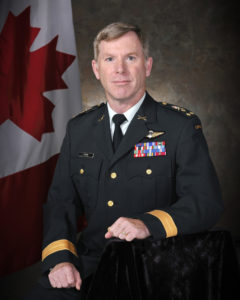
LGen (ret’d) Stuart Beare retired in fall 2014, having served 3 years as the Commander of Canadian Joint Operations Command – charged with the anticipation, preparation for, and conduct of CAF operations, in all domains, at home and globally. He was Commander Land Force Doctrine and Training System and then Chief of Force Development. He is also a Fellow of the Canadian Global Affairs Institute.

